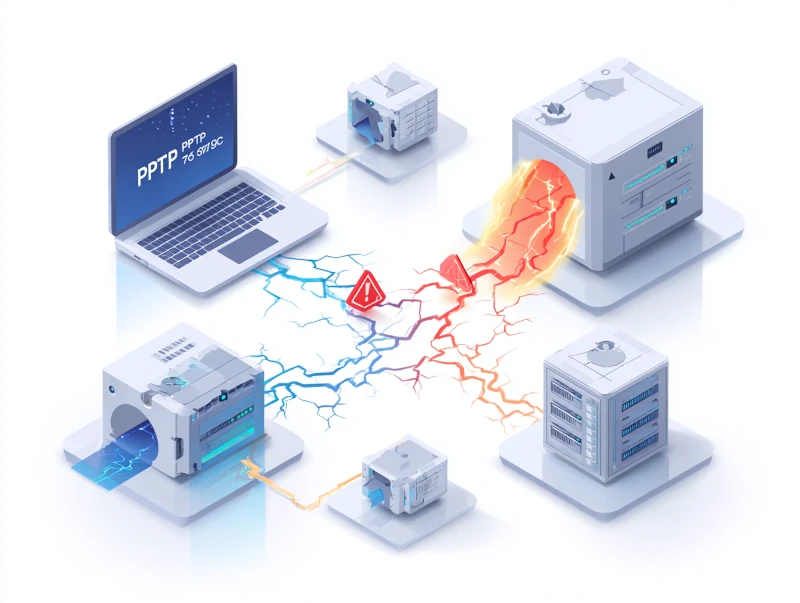WPA3 Security Testing
WPA3 security testing requires complex SAE and EAPOL analysis; Penzzer enables fuzzing by acting as a controllable WPA3 Access Point for devices.

Virtual Private Networks (VPNs) are fundamental to secure communication in modern computing, but not all VPN protocols are created equal. One of the earliest and most widely adopted VPN protocols was PPTP (Point-to-Point Tunneling Protocol). Although it has since been declared obsolete due to severe security flaws, understanding PPTP remains important for several reasons:
In this blog post, we'll cover:
By the end, you'll not only understand the inner workings of PPTP but also how modern fuzzing can help uncover vulnerabilities in legacy protocols that may still lurk in critical infrastructure.
PPTP (Point-to-Point Tunneling Protocol) is a network protocol developed by a consortium led by Microsoft in the mid-1990s. Its primary purpose was to enable Virtual Private Networks (VPNs) by tunneling PPP (Point-to-Point Protocol) traffic across IP-based networks.
The key design goal of PPTP was to provide:
At the time, this combination made PPTP a popular choice for enterprises and individuals alike. It was supported natively on Windows 95 OSR2 and Windows NT 4.0, which gave it a significant adoption advantage.
PPTP creates a virtual tunnel between a client and a server over an IP network. It uses two main components:
PPP itself supports multiple authentication protocols (e.g., PAP, CHAP, MS-CHAP) and can carry multiple network layer protocols (e.g., IP, IPX). PPTP extends this by allowing PPP sessions to be tunneled across an IP network.
While PPTP is not an IETF standard in the strict sense, it was documented and published in the following key RFCs:
RFC 2637 is the cornerstone, describing PPTP's architecture, message format, and operation.
PPTP defines a set of control messages exchanged between the client and server, along with GRE encapsulated data messages.
PPTP control messages are sent over TCP port 1723. Each control message has the following general structure:
0x1A2B3C4D.
Once the control connection is established, data is tunneled via GRE encapsulation. GRE headers include:
0x0100 (PPTP v1.0).
The main reasons PPTP is considered obsolete today:
Despite this, PPTP is still enabled on some routers, IoT devices, and enterprise VPN setups due to legacy dependencies.
Given PPTP’s historical weaknesses, why fuzz it today? There are three main reasons:
PPTP fuzzing involves:
Modern fuzzing frameworks like Penzzer are well-suited to testing PPTP because they can model stateful, multi-channel protocols and automate large-scale input mutation.
When acting as a PPTP client, Penzzer:
This mode is ideal for testing PPTP servers such as routers, VPN appliances, or embedded devices.
When acting as a PPTP server, Penzzer:
This mode is ideal for testing PPTP clients, including legacy Windows clients, mobile apps, or IoT devices.
This is where Penzzer’s ability to act in multiple roles and monitor network behavior becomes valuable.
Even though PPTP is obsolete, it still appears:
For security researchers, fuzzing PPTP remains a valuable exercise in discovering implementation bugs, some of which could still be exploitable in real-world systems.
PPTP is an outdated and insecure VPN protocol, formally defined in RFC 2637, with extensions in RFC 3078 and RFC 3079. While once popular for its simplicity and native support in Windows, it has long been replaced by stronger alternatives like IPSec, OpenVPN, and WireGuard.
Despite its obsolescence, PPTP remains relevant to security research. Fuzzing, particularly with advanced tools like Penzzer, can uncover lingering vulnerabilities in PPTP-capable devices and software. By operating as both client and server, Penzzer enables a comprehensive fuzzing strategy, systematically probing for weaknesses in every stage of the protocol.
Understanding PPTP is not just about studying an old VPN technology, it's about learning how to analyze, fuzz, and secure protocols in general. For security professionals and researchers, this knowledge translates directly into better strategies for handling both legacy and modern systems.

Identify security flaws before attackers do, automatically and at scale with Penzzer's intelligent fuzzing engine.
